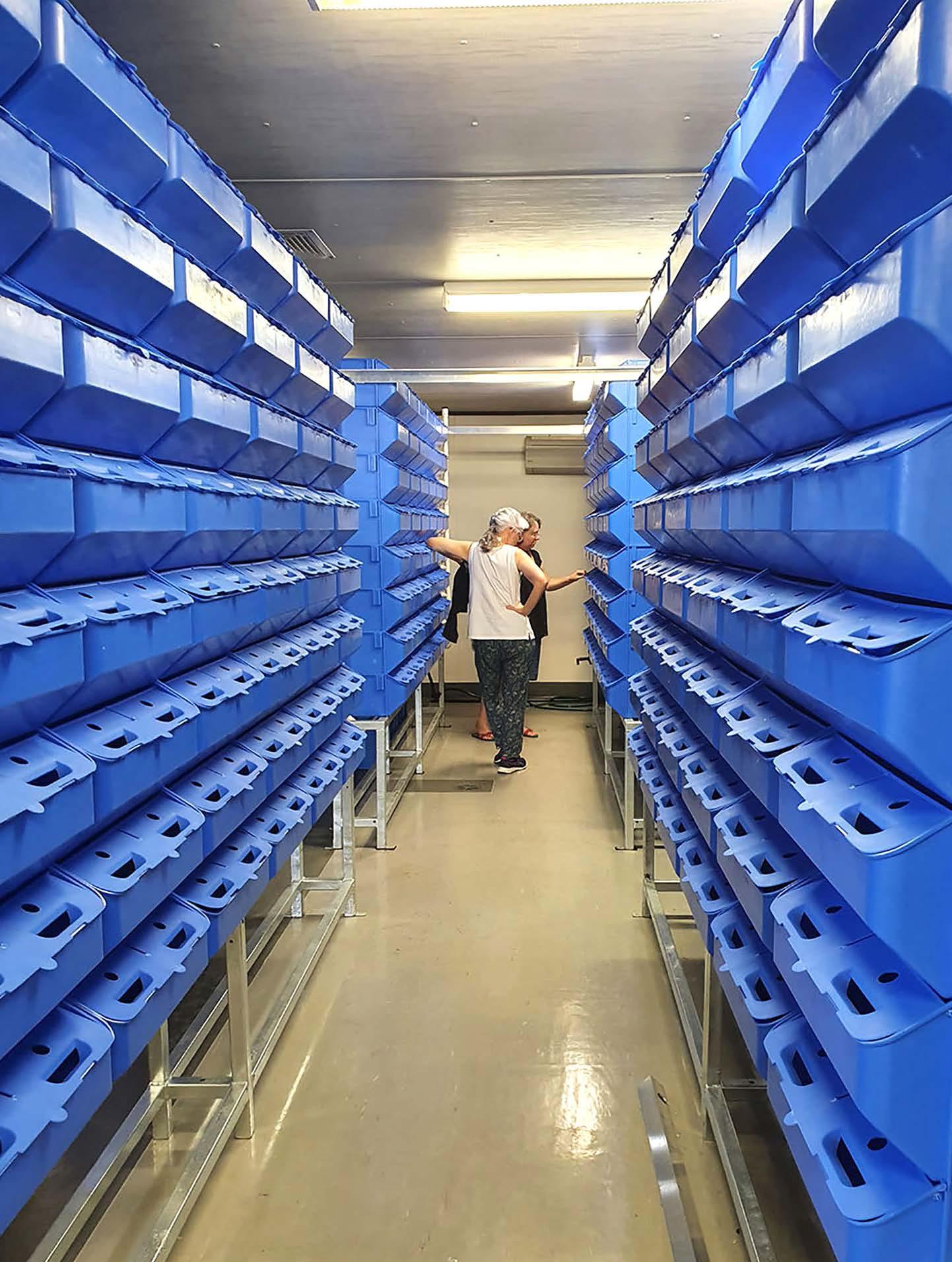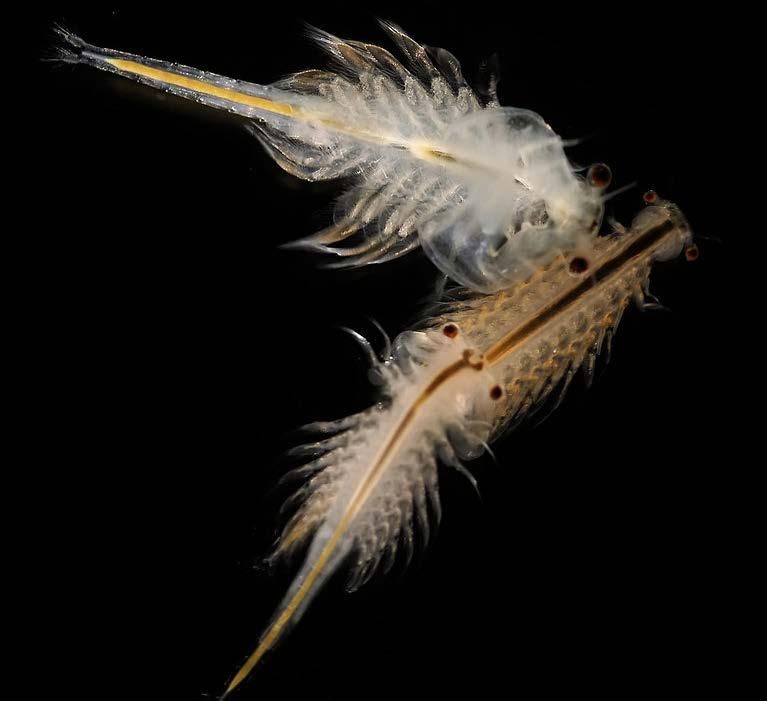
8 minute read
AQUAFEED
Recent news from around the globe by Aquafeed.com
By Suzi Dominy*
Developments in hatchery feeds Since hatcheries are the focus of this issue, it seemed appropriate to discuss recent developments in hatchery feeds that we have covered over the last few months through our dedicated hatchery media, HATCHERY Feed & Management (Hatcheryfm.com).
Alternative proteins have been a constant theme in this column, and hatcheries have not escaped the trend. The market for freshwater crayfish is worth some US$7.6 billion, and demand consistently exceeds supply. In the last issue of HATCHERY Feed & Management magazine, Asher Ariel of the Australian Crayfish Hatchery (ACH) explained that this is due to traditional production methods that are labor-intensive, season-dependent and fraught with inbreeding impacts. Describing how ACH had brought together innovative technologies for intensive production of redclaw crayfish seedstock, including RAS, he noted the major impact of nutrition on health and survival. ACH has eliminated live feeds and has developed a fishmeal-free feed for crayfish hatchlings and broodstock. The feeds are based on insect-derived protein which is produced onsite - maintaining a high level of biosecurity; it is both sustainable and renewable.
“Preliminary trials have shown an increase in crayling survival from less than 50% to greater than 90% compared to traditional fishmealbased larval feeds. In addition, an unexpected benefit was also quickly realized. The fishmeal-based feeds led to high ammonia levels requiring extensive biofiltration and water quality management to control. In contrast, using our Entomix diet, we recorded a dramatic reduction in ammonia – a significant bonus in RAS facilities, reducing labor and production costs”.
ACH is currently undertaking high-level trials to investigate the effect of Entomix on broodstock health, fecundity and egg quality to further optimize their production technologies. Early-stage trials have shown great promise, with an average fecundity of 12 eggs per gram of female and greater than 95% egg survival to hatch.
It’s not all alternatives however. Feed company Aller Aqua and marine ingredients producer TripleNine are seeing results of a research collaboration entered into in 2019 to identify functional components of marine raw materials, with particular attention to their beneficial performance in terms of fish health and growth, as well as sustainability.
At Aller Aqua’s research facility, rainbow trout were fed on different diets containing TripleNine’s functional marine ingredients from first feeding until they reached fingerling size. The functional ingredients led to positive effects on fish growth performance and health and provid-

Australian Crayfish Hatchery.

ed excellent survival rates in the test groups. R&D director at Aller Aqua, Hanno Slawski explained that TripleNine’s marine ingredients are nutritionally valuable fish feed ingredients but using them as concentrated functional ingredients, their impact increases. In the future, 999Vital will serve as set functional ingredients in Aller Aqua’s starter feeds. Ongoing tests will further evaluate the effects in grow-out and broodstock stages for other possible applications.
The rise of RAS The design and management of RAS systems consume more and more column space in HATCHERY Feed & Management news coverage, and in the magazines. Feed companies are working hard to tailor feeds specifically for the increasing number of species being raised in these systems. Most recently, BioMar has scaled up RAS and fry feed production. The new production line in Brande, Denmark, is now fully operational. The line is dedicated to RAS and fry aquaculture feed production and is the result of a DKK 100 million ($15.33 million) investment that has enabled BioMar to increase the annual capacity of the Danish facility by 25%.
“Being situated in an area with a long history of RAS research and development has enabled us to be first movers in RAS feeds and will continue to be crucially important in the innovation development of feeds for land-based farming. There is good recognition for our RAS feeds globally and our ambitions for this growing segment are high”, Carlos Diaz, CEO BioMar Group said.
The facility has experience in specially designed feeds for more than 40 aquaculture species, including trout, salmon, and yellowtail kingfish. The investment project has been able to increase the overall capacity by 25% up to 160,000 tons of feed produced annually with improved flexibility, quality, and production performance. Pellets coming out of the new line are now in a much better diameter: length ratio, the inter-size gap has been improved for at smoother transition between pellet sizes. The improved process control technology on the new line will further strengthen BioMar’s ability to focus on more physical quality parameters such as sinking speed and water stability.
Feed may be an important component in mitigating the effects of off-season spawning in RAS systems, on egg nutrients. The Norwegian Institute of Marine Research and Aquagen compared salmon spawning out of their regular spawning season in a land-based RAS facility to salmon spawning in the regular spawning season. Normally, broodstock are kept in the sea and transferred to land-based freshwater facilities to spawn in the fall, simulating the natural travel of salmon. In contrast, broodstock can be kept in RAS facilities throughout the entire maturation period, so farmers can shift the spawning season from autumn to summer by controlling both light and temperature of the water. This is how they gain access to new generations of salmon throughout the year.
Australian Crayfish Hatchery.
Researchers found that the broodstock that spawned during the offseason had higher levels of B vitamins, amino acids and fats compared to the fish from normal spawning season, but the eggs contained lower levels of these nutrients compared to the eggs from the normal spawning.
“Results showed that the broodstock that spawn off-season does not transfer enough nutrients to the eggs and that the maturation is not optimal to achieve good growth for the next generation,” said researcher Kaja H. Skjærven. “Fats and amino acids are used both as an energy source and for growth by forming new membranes and proteins and if the eggs have less of this, the fish larvae will also become smaller.”
The only difference in the experiment was the broodstock environment, which changed the nutritional content of the eggs and researchers

suggest that they may need an improved feed to get the same maturation in the off-season than in the normal spawning season. Adjustments of feed, temperature and light will probably allow equally good maturation of off-season eggs.
Researchers are now investigating whether the differences in growth may be due to nutritional-based regulation of the genetic material, so-called epigenetic gene regulation mechanisms. That is if the nutritional status of the broodstock can affect how active the genes inherited from the parents are.
Live feeds The production of high-quality marine fish fry is limited by the low survival observed during the larval phase, which is often attributed to dietary deficiencies of the diets at first feeding. Despite progress made with live feed (i.e. rotifers, Artemia) and enrichments, little is known about the micronutrient requirements, such as for selenium.
Selenium is a critical component of several enzymes maintaining important biological functions such as cellular oxidation, and therefore, plays a key role in oxidative and stress status of marine larvae. The levels of selenium found in the larvae’s natural diet (i.e. copepods) are generally higher than those of the enriched live preys used in hatcheries.
A team of researchers from the University of Stirling and the Spanish IATS-CSIC performed a study to establish a protocol to enrich Artemia nauplii with selenium using different inorganic (sodium selenite) and organic (selenoyeast) sources.
Results indicated that the use of dissolved sodium selenite, an alternative inorganic and cheaper form
BioMar’s new RAS and fry feed production line at their Brande, Denmark feedmill is now operational.

of selenium, did not increase the levels of selenium in the nauplii. However, the use of selenoyeast confirmed that it is possible to enrich the nauplii with targeted levels of selenium since this process followed a dose-response pattern with selenium enrichment ranging from

1.7 to 12.4 mg kg-1. Besides, the supplementation of the product to the regular enrichment product did not impact on lipids and fatty acids enrichment irrespective of the dose dispensed.
Live feed as a vector for disease is an ongoing concern. A group of South Korean researchers tested eco-friendly plasma-activated water (PAW) to disinfect Artemia cysts. PAW is an emerging non-thermal disinfection and surface modification technology that is chemical-free and eco-friendly. Plasma treatment of water creates an acidic environment which results in changes in the redox potential, conductivity and in the formation of reactive oxygen and nitrogen species. As a result, PAW has a different chemical composition than water and can serve as an alternative method for microbial disinfection.
Researchers infected Artemia cysts during hatching using different bacteria species (Vibrio alginolyticus, Vibrio harveyi, Vibrio parahaemolyticus and Edwardsiella tarda). The PAW disinfection rapidly reduced the bacteria load in cysts for up to three hours after treatment. The efficacy was higher in Artemia cysts inoculated with V. harveyi.
The hatching rate of Artemia cysts infected with V. harveyi was reduced but recovered after PAW treatment. The hatching rate of the cysts that were not disinfected was reduced by 17.6%, but the cysts treated with PAW showed a significant increase in the hatching rate.
Researchers suggest that plasmaactivated water can be used as an alternative disinfectant in aquaculture, especially to sterilize fish eggs.
Suzi Dominy is the founding editor and publisher of aquafeed.com. She brings 25 years of experience in professional feed industry journalism and publishing. Before starting this company, she was co-publisher of the agri-food division of a major UK-based company, and editor of their major international feed magazine for 13 years. editor@aquafeed.com








